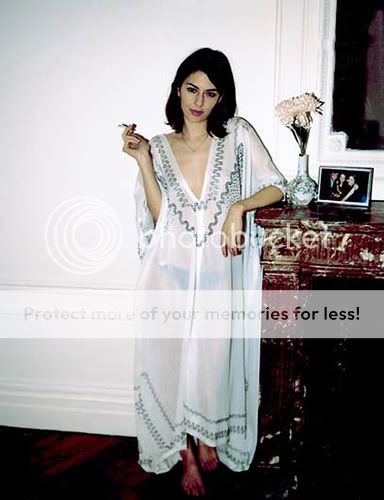
"El que lee mucho y anda mucho, ve mucho y sabe mucho."
sábado, 26 de junio de 2010
miércoles, 23 de junio de 2010
viernes, 18 de junio de 2010
martes, 15 de junio de 2010
Extra lemons.
We liked bizarre people because we didn't really take ourselves that seriously, and we were amused about how seriously everybody else seemed to take themselves. That was our approach at that point.
We rode around in that gray Mercedes, staying up all night after the discotheques closed at four. Sometimes I'd drive, but Edie loved to drive herself... it was like riding a horse. She told me all about her family. She seemed to love her mother... it was almost "the poor dear... the poor thing is going to be so worried." CHUCK WEIN
We rode around in that gray Mercedes, staying up all night after the discotheques closed at four. Sometimes I'd drive, but Edie loved to drive herself... it was like riding a horse. She told me all about her family. She seemed to love her mother... it was almost "the poor dear... the poor thing is going to be so worried." CHUCK WEIN
*
Edie got into spending her inheritance. It was a time when the discotheques were opening - like Ondine - and people were beginning to live up in places like that. We often went stoned drunk to a place called L'Avventura to have these gigantic diners. Edie loved salmon. And extra lemons on her Bloody Marys. All that extra this and extra that. She ate vast quantities of shrimp. Shrimp and salad, stuff you would think was healthy. But she had four of whatever it was.
I quit my job at the Right Bank restaurant to be her chauffeur. She paid me one hundred dollars a week. We had first met in Cambridge when she was studying sculpture and had gotten to be friends in a curious non-lover way. It was a bit of a strange arrangement to be her chauffeur, but it seemed okay to me. Then I went pow into a taxi in front of the Seagram building and cracked up her Mercedes. I felt so sad, because she loved that car. But it didn't faze her in the least. She didn't get angry. We began travelling in limousines. TOM GOODWIN
EDIE: AN AMERICAN BIOGRAPHY
Copyright Jean Stein and George Plimpton 1982
lunes, 14 de junio de 2010
Tiny apartment
Edie moved from her grandmother's late that fall of 1964 to an apartment in the East Sixties between Fifth and Madison. Her mother came to town and took Edie shopping to furnish the apartment. Suddenly this empty room was full of the sort of ornaments prosperous people have who've been living in the same place for years and years... solid crystal paperweights, great fur scatter rugs, fabulous embroided pillows, one of those enormous leather rhinoceros from where?... Abercrombie and Fitch, wasn't it? Elaborate cigarette lighters, really heavy and solid. Most of them never worked; Edie never bothered to fill them. She didn't have affection for any of these things: a lot of them she didn't even understand. None of this was collected with any love or preference, but just provided with a snap of fingers. She was always sending to Reuben's restaurant... blinis and caviar, always caviar. It was almost a game... everything had to be the ultimate. I guess she was extremely spoiled, because she was given whatever she wanted... a leopard-skin coat that must have come from her parents unless it was from an unkown admirer. A real leopard-skin coat! About the only thing that was her own was a huge horse above her bed that she'd drawn on the wall with pencil.
It was a tiny apartment. Sometimes the garbage was pretty messy in the kitchenette. She would let it go pretty far before she took emergency measures... someone would volunteer to reach into the sink and unclog it.
There was a lot of acid around then... LSD... the first days of it, and most of those people down from Cambridge knew Timothy Leary and Richard Alpert. In the refrigerator they used to keep little brown vials of liquid to drop on a sugar cube. Edie would drive her Mercedes on acid! I thought that was the most daredevil thing she'd ever been to... I mean, she'd go up on curbs sometimes, and she'd never pay much attention to traffic lights. It was like everything else: her own rules applied. DANNY FIELDS
EDIE: AN AMERICAN BIOGRAPHY
Copyright Jean Stein and George Plimpton 1982
domingo, 13 de junio de 2010
I remember when I lost my mind
Edie was living at our grandmother's apartment at Seventy-first and Park. She saw uptown people. But she felt awkward being at our grandmother's and her bizarre habits were a great strain on the household - the servants were going bananas. Edie would take off on these enormous spending sprees: her closets and drawers were crammed full. I've never seen so many clothes in my life! Just incredible- Edie udes the place rather the way we all did... staying there the way you stay at a club... but it got out of hand. SAUCIE SEDGWICK
*
Edie had always dressed to conform to my mother's taste - little Peck and Peck costumes with navy blue sweaters - but in New York one day I suddenly saw her in this little red fox fur waistcoat with a matching hat and huge peacock-feather earrings, some kind of outlandish bag, black stockings, and high-heeled boots, none of which was in fashion then at all. Iwas very shocked. I said to her, "Is this the way you want to go around?" She said, "I think it's fun." SAUCIE SEDGWICK
EDIE: AN AMERICAN BIOGRAPHY
Copyright Jean Stein and George Plimpton 1982
viernes, 11 de junio de 2010
jueves, 3 de junio de 2010
Suscribirse a:
Comentarios (Atom)
Mood Board
Pablo Neruda
Sofia Coppola
Françoise Hardy
Edie Sedgwick
José Lezama Lima
Julio Cortázar
Audrey Hepburn
Bob Dylan
Brigitte Bardot
Francisco de Goya
Roberto Bolaño
William Blake
Ernest Hemingway
Joan Baez
Terunobu Fujimori
Allen Ginsberg
Françoise Truffaut
Gonzalo Rojas
James Abbott McNeill Whistler
Luis Barragán
Marianne Moore
Nicanor Parra
Pablo Picasso
Anna Karina
Arthur Rimbaud
Balzac
Bernardo Bertolucci
Billy Wilder
Catherine Deneuve
Edgar Allan Poe
Eric Rohmer
Ernesto Cardenal
Franz Kafka
Gary Cooper
George Borrow
J.M.W. Turner
Jean Fragonard
Jean Luc Godard
Jean Seberg
Jorge Guillén
Kate Moss
Lord Byron
Mario Benedetti
Patrick Vale
Patti Smith
Pieter Bruegel
Sam Haskins
Stanley Kubrick
Susan Sontag
Terrence Malick
Van Gogh
Walt Whitman
Wim Wenders
Woody Allen
Albert Camus
Alberto Durero
Alfonso Camín
Anaïs Nin
Andy Warhol
Anne Bradstreet
Annie Leibovitz
Anthony Minghella
Anton Corbijn
Astrid Kirchherr
Beethoven
Benjamin Franklin
Bigas Luna
Carmen Laforet
Cary Fukunaga
Caspar David Friederich
Charles Baudelaire
Charles Bukowski
Charlotte Rampling
Che Guevara
Claes Oldenburg
Claude Monet
Clémance Poésy
Coco Chanel
D. H. Lawrence
Darren Aronofsky
Edward Hopper
Elia Kazan
Enrique Rojas
Ezra Pound
F.S. Flint
Federico Fellini
Florence + The Machine
Foo Fighters
Francisco de Quevedo
Frank Gehry
Friederich Schiller
Garry Winogrand
Giovanni Battista Piranesi
Helmut Newton
Hunter S Thompson
Inez vam Lamsweerde and Vinoodh Matadin
Jack Kerouac
James Blake
Jane Austen
Jane Birkin
Jean Baudrillard
Jean Paul Belmondo
Jean Paul Sartre
Jeremy Kapone
Jimmy Hendrix
Jonathan Dayton
Jorge Luis Borges
Joseph Szabo
Juan Marsé
Katherine Ross
Keith Richards
Kurt Cobain
Langston Hughes
Lauren Bacall
Leopoldo María Panero
Luís Buñuel
Marc Webb
Marcello Mastroianni
Mario Monicelli
Mario Testino
Mat Kazman
Mia Wasikowska
Michael Jackson
Michelangelo Antonioni
Mick Jagger
Nicole Krauss
Nietzsche
Onetti
Oscar Niemeyer
Peter Eisenmann
Philippe Starck
Pink Floyd
Quentin Tarantino
Rem Koolhaas
Roald Dahl
Robert Delaunay
Roger Vadim
Roman Polanski
Rubén Darío
Salvador Dalí
Simone de Bouvoir
Terje Rypdal
Terry Rodgers
Victor Hugo
Víctor Erice
William Wyler
Fractales
Places
Archivo del blog
-
►
2013
(157)
- ► septiembre (16)
-
►
2012
(184)
- ► septiembre (15)
-
►
2011
(146)
- ► septiembre (34)
-
►
2009
(17)
- ► septiembre (1)













